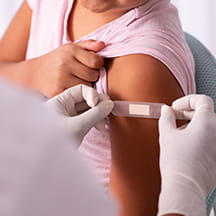When Heather Kreth joined the inpatient behavioral health team at Monroe Carell Jr. Children’s Hospital at Vanderbilt, she found numerous examples across the institution of excellent work being done to address the increasing numbers behavioral health patients—many of whom were in crisis. But something was missing.
“We felt like we needed to synthesize those things and make them more cohesive,” says Kreth, Psy.D., associate professor of clinical pediatrics and clinical director of inpatient behavioral health at Monroe Carell in Nashville, Tennessee. “It was not a quick fix—it’s been a long journey, actually—but we’ve taken a multidisciplinary approach to pull things together from the nursing, clinical expert and ancillary support sides to make sure we are doing as much as possible to provide individualized care for patients and improve safety.”
That journey culminated in the creation of a behavioral health toolkit to ensure evidence-based, standardized care for all of Monroe Carell’s patients.
Five elements of the behavioral health toolkit
The toolkit is part of Monroe Carell’s initiative to create an innovative care delivery model to address the growing behavioral health crisis among children and teens. Building upon elements already in place at the hospital, the behavioral health toolkit consists of five primary components:
- Broset Violence Checklist (BVC). A short-term violence prediction instrument assessing confusion, irritability, boisterousness, verbal threats and physical threats or attacks. Patients under 18 years old presenting with one of 20 serious behavioral health diagnoses are required to complete this assessment within four hours of admission.
- Admission Orders. Standardized protocols allowing providers to individualize admission orders based on a patient’s specific needs.
- My Health Passport. Allows the mental health specialists or nurses to gather additional information directly from the patient or their guardian about patient-specific preferences, needs and triggers. “It's our way of really developing a care plan for the patient,” says Andrea Hughie, M.S.N., RN, NEA-BC, associate nursing officer at Monroe Carell.
- Stoplight Safe Activity List. Used internally as a staff resource to individualize patient access to coping and comfort items.
- Shared Behavioral Plan of Care. Automatically displays to all clinicians accessing the patient’s electronic medical record. The details in the plan inform staff of individualized, evidence‐based interventions to decrease agitation and episodes of aggression.
The toolkit also provides informational sheets for care providers to share with patient families to educate them on their child’s care and ease any concerns or fears they may have. But the toolkit’s main purpose is to alleviate any hesitations providers may have in caring for behavioral health patients.
“There's a different level of emotion and attention with caregivers for these kids,” Hughie says. “Providing the structure, evidence and proof of concept that these folks are craving while also calling out that there can be fear and emotion in caring for kids with behavioral health care needs—we were really intentional in leaning into that in our toolkit.”
The success of the behavioral health toolkit
The hospital has seen statistically significant reductions in the use of patient restraints and OSHA-recordable staff injuries since the toolkit’s implementation. There have also been significant decreases in employee injuries resulting in DART (days away, restricted or transferred work duties)—in fact, Monroe Carell recently went 618 days without such an event.
Key to those successes, according to Hughie, is not resting on their laurels. By continuously evaluating the effectiveness of the tools and conducting root-cause analyses following any incidents, the hospital constantly refines its processes. “An example of that early on in our journey was when we had bigger kids, our staff would become more fearful—but actually, it was kids under 10 where we had the most injuries,” Hughie says. “We restructured our focus on school-aged children and how to be more intentional in preventing staff injury.”
The other crucial component: communication.
“You can have all the toolkits in the world, but if you don't have a team of folks who are looking after each other and talking to each other on a daily basis, it's not going to work,” Kreth says. “If you're trying to do things in isolation with kids across lots of different teams and nobody's talking to each other, things are going to fall through the cracks.”
Access the complete behavioral health toolkit, plus additional resources.


